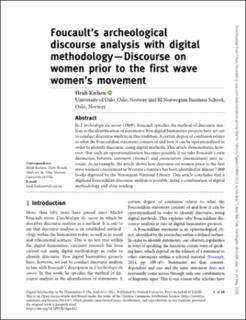Foucault’s archeological discourse analysis with digital methodology—Discourse on women prior to the first wave women’s movement
Peer reviewed, Journal article
Published version
Permanent lenke
https://hdl.handle.net/11250/2997078Utgivelsesdato
2022Metadata
Vis full innførselSamlinger
- Scientific articles [2181]
Originalversjon
Digital Scholarship in the Humanities. Online First 06 May 2022. 1-14. 10.1093/llc/fqac022Sammendrag
In L’archéologie du savoir (1969), Foucault specifies the method of discourse analysis as the identification of statements. Few digital humanities projects have set out to conduct discourse analysis in this tradition. A certain degree of confusion relates to what the Foucauldian statement consists of and how it can be operationalized in order to identify discourse, using digital methods. This article demonstrates, however, that such an operationalization becomes possible if we take Foucault’s own distinction between statement (énoncé) and enunciation (énonciation) into account. As an example, the article shows how discourse on women prior to the first wave women’s movement in Western countries has been identified in almost 7,000 books digitized by the Norwegian National Library. This article concludes that a digitized Foucauldian discourse analysis is possible, using a combination of digital methodology and close reading.

